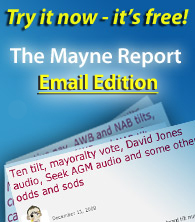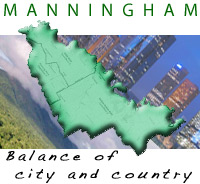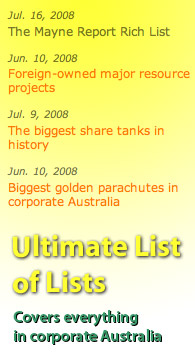Vic budget myths, sporting MP's, Macquarie, Rio
July 22, 2008
Here are Stephen Mayne's four stories from the Crikey edition on Wednesday, 31 May, 2006.
2. Debunking the Victorian budget myths
By Stephen Mayne
Public sector accounting remains a sad joke in Australia – witness Peter Costello's failure to put a $29 billion blowout in unfunded superannuation through his budget bottom line – but even worse is the fact that the media so often buys bunkum. For instance, the Herald Sun's editorial on Victoria's finances today included this second paragraph:
Treasurer John Brumby's budget is a something-for-everyone document which, despite an outlay or $32.125 billion, has a projected surplus of $317 million.Bollocks. The big spending Bracks Government is actually forecasting cash deficits of between $700 million and $900 million over the next four years, which will blow out gross debt from $6 billion to $10 billion by 2010. And don't let's start on the net debt myth.
The Herald Sun is actually referring to what the government calls the "operating surplus", but why on earth should a budget not include capital works on new schools, roads and hospitals when this is something that governments do? Sure, strip out one-offs such as proceeds from the Snowy Hydro sale, but to report a budget without dealing with regular capital expenditure is misleading.
Even worse than pretending capital works don't exist, the Bracks government has committed to an additional 16 projects worth $4.5 billion that have been funded through those off-balance sheet public-private partnership ruses.
Then you have all this rubbish about new spending or tax cuts which are tallied up over a four period. That led to some papers today claiming the Bracks budget delivered "$1.4 billion in tax cuts". If everyone else can talk about things on annual terms, why does the public sector introduce a 300% inflator?
Given that total Victorian government revenue over the next four years will be about $136 billion, we're actually talking a very modest tax cut of about 1%. The payroll tax cut from 5.25% to 5% is phased in over three years and the saving in the first year is just $61 million, but this comes after budgeted payroll tax receipts were revised up by $178 million to $3.357 billion in 2005-06, so the government is giving less back than the windfall gain they've enjoyed thanks to a strong jobs market.
Then there are the trumpeted cuts in land tax rates, but you still have to remember that the Bracks government inherited a land tax system that delivered $378 million in 1998-99 and, even after all these so-called tax cuts, is budgeted to deliver $747 million in 2006-07.
The other budget myth is that Victoria is not benefiting from the resources boom and this ties in to the biggest and most important tax cut announced yesterday – a 10% across the board reduction in WorkCover premiums to a record low of 1.62% of payroll.
Yesterday's cut will directly save $170 million in 2006-07 and this is the third straight 10% cut in premiums so annualised savings will reach an impressive $520 million – or $2.1 billion over four years in public sector speak. However, this has only been possible because the stockmarket has almost doubled over the past three years and that is being largely driven by the global resources boom and China.
The same applies to the $600 million that was ripped out of the Transport Accident Commission – the government largely got this windfall from its monopoly compulsory third party insurer thanks to booming investment returns.
Indeed, Victoria's unfunded superannuation liability actually fell by $2.8 billion to $12.5 billion in 2005-06 and this was also driven good investment returns thanks to commodity prices and China.
Victorian taxpayers are even running a direct punt on the aluminium price through the Cain Government's 30-year power supply deal with Alcoa where the tariff rises and falls with the spot price. Back in the bad old days, taxpayers were subsidising the Portland and Point Henry aluminium smelters to the tune of $200 million a year, although this in part reflected the inflated costs of the old state-owned SECV.
Now the budget is forecasting taxpayers will make a profit of $486 million over the forward estimates because aluminium prices have soared to record highs and Alcoa is now paying far more power than it costs taxpayers. So please, enough of this stuff about Victoria not benefiting from the resources boom.
15. Sporting MPs – the good and the very bad
By Stephen Mayne
It's becoming apparent that sporting prowess has been a popular path into politics, but the question remains as to whether these people have made effective members of parliament. Sure, there's been some good ones like Ray Groom but many sporting types wouldn't have a clue about politics. Take former Geelong centre half-forward and Footy Show layabout Billy Brownless – you only need to read this hilarious transcript from a Mark Willacy story on PM in 1999 to get a sense of what can happen when a bonehead toys with entering politics.
Meanwhile, here are another ten sporting names who made the transition and five more who fell short of the desired career change into politics:
Ten more sporting types who made it into Parliament
Michael Cleary: Triple international (rugby union, rugby league, Commonwealth Games athletics) – ALP member for Coogee in NSW parliament 1974-91, minister for sport 1981-88.
Brian Dixon: Played for Melb and coached North – Member for St Kilda and Minister for Yoof, sport and Rec
John Fahey: NSW Liberal Premier and federal Finance Minister who previously played first grade rugby league for Canterbury-Bankstown.
Alan Grice: Former car racing driver won the Queensland state seat of Broadwater in 1992 but was swept from office with a 13% swing at the 2001 election.
Ray Groom: Liberal Premier of Tasmania 1992-96 who also played 92 games for Melbourne from 1963-68 and even won the best and fairest trophy in 1968.
Mac Holten: Collingwood centre-half-back who played 82 games and went on to hold the Federal seat of Indi for the Nationals in the 1960-70s.
Kevin Ryan: Dual rugby union and rugby league international in the 1950s and 1960s, who then went on to hold the NSW state seat of Hurstville for Labor from 1976–84.
Frank Stewart: Federal ALP member who played rugby league for Canterbury-Bankstown in the late 1940s.
Tom Uren: Whitlam government minister and ALP legend who contested the Australian heavyweight boxing championship in 1941.
Peter Watson: 1968 Olympian and sub four minute mile runner who won the WA state seat of Albany in 2001 for the ALP after 27 years with the Liberals, but it reverted back in 2005 so he was a one term wonder.
Five more who tried and failed
Mike Bowden: Richmond premiership player and father of current players Joel and Patrick. Unsuccessfully stood for Labor in Araluen in Alice Springs in 2001
Carl Ditterich: St Kilda and Melbourne thug who got close to winning the Victorian seat of Swan Hill as an independent in 1999.
Barry 'the grasshopper' Gomersall: The former rugby league referee has run for the NSW seat of Mirani at the last five elections – in 1989 as a Liberal candidate, then three elections as the Labor candidate and as an Independent in 2001.
Peter Thomson: Golfer par excellence but failed to be elected as a NSW Liberal State MLC, although his son Andrew then held Wentworth and was Tourism Minister in the first Howard Government before being sacked over the phone.
Dirk Wellham: Test cricketer and Sheffield Shield captain for three states (NSW, Qld, Tas) – unsuccessfully sought Liberal pre-selection for a NSW state seat in the early 1990s.
25. Macquarie Bank bounces back over MCG items
By Stephen Mayne
Our friends at Macquarie Bank have been in touch and offered up a detailed reply to last week's items about Macquarie Communications Infrastructure Group. The company with the alluring ASX code of MCG operates Broadcast Australia – the business which owns the transmission towers used by the ABC and SBS. The whole debate has been packaged up here on the site but some of the key points made by the Millionaire Factory include the following:
CRIKEY: “BA's EBITDA margins are at 60%”
This is true and reflects efficient use of BA's assets. It primarily reflects the fact that BA is an infrastructure services business that is highly capital intensive. As such BA has high capital expenditure each year and incurs significant depreciation, amortisation (goodwill and intangible contracts) and interest charges below the EBITDA margin line. When these costs are taken into account BA generated a margin of 14.4% in the year to June 2005.
CRIKEY: “BA loves the 'glacial conversion to digital' because ABC and SBS have to pay for analogue and digital”
MCG and BA in particular, have been strong public advocates of the move to digital services. They have made such statements to the financial markets, the media, the Department of Communications, Information Technology and the Arts (DoCITA), as well as the Australian Communications and Media Authority (ACMA). BA has been consistent in all its recommendations to Government and relevant agencies over the past four years as to the steps required to accelerate the take up of digital terrestrial receivers by the public. Only with this take-up will it be possible for the analogue TV switch off to occur.
MCG believes that the analogue spectrum released from analogue switch off could be redeployed and used by the industry for other innovative services. BA would be well placed to provide transmission services at that time. Indeed, analogue switchover is seen as an incremental opportunity for BA's revenue.
CRIKEY: “Digital TV transmission can be as much as $100k per site per annum”
Transmission fees are established either through tender or direct negotiation and reflect the complexity and cost of delivering broadcast services from any one site. In the case of the ABC digital transmission fees were established under contract only after a lengthy tender process in 1999 and 2000, and following an independent assessment by Government as to the value for money offered by BA.
CRIKEY: “Many people in the ABC believe they are paying too much for digital transmission”
ABC is paying prices which reflect market rates. The prices were agreed following a lengthy competitive tender process in 1999 and 2000 (ie well before MCG was created) and the prices were subject to independent consultants (appointed by the Government) to confirm the value for money offered by BA. ABC's analogue contract pricing was established between the ABC and the Federal Government PRIOR to privatisation. It is MCG's view that the analogue pricing does not fully take into account the capital and operating costs of the analogue network.
CRIKEY: “Facilities lessees have experienced rental increases of 1000% since 2002”
Facilities leasing arrangements are now entered into at market rates. (The exception is self help community broadcasting which BA and the Government agreed to heavily subsidise). As existing agreements – that were entered into by the Federal Government – expire, BA is repricing these arrangements to market rates. When this happens the increase to market or near market rates can represent a significant percentage increase. BA does seek to negotiate in circumstances where it is obvious the tenant is unable to bear the full extent of the increase.
26. Rio Tinto just 15% Australian owned
By Stephen Mayne, who sold 18 BHP Billiton shares this week after doubling the original $500 investment
The world's second biggest mining company Rio Tinto has a lower level of Australian ownership than first thought, after aggressively pursuing the North American investment market over the past few years. The ownership break down of the $95 billion dual-listed company, which has 56% of its assets in Australia, is as follows:
UK: 50%
North America: 20%
Australia: 15%
Europe: 10%
Asia: 5%
Contrast that with the $150 billion BHP-Billiton which breaks down as follows:
Australia: 40%
UK: 25%
North America: 15%
South Africa: 10%
Asia: 5%
Europe: 5%
Therefore, in today's five $1 billion-plus resource projects for our great "who owns Australia" list we're focusing on Rio Tinto:
Hope Downs: Rio Tinto 50% and billionaire Gina Rinehart's Hancock Prospecting 50%, so Australian ownership is a healthy 57.5% at what will be Australia's newest iron-ore mine when the $1.3 billion project goes into production by 2008. Full annual capacity of 22 million tonnes would generate $1.6 billion a year based on the 2006-07 contract prices of $70 a tonne.
Eastern Range: Rio Tinto 54% and Shanghai Baosteel Group Corporation 46%, so overall Australian ownership just 8.1%. Produces 6.5 million tonnes a year worth $450 million based on 2006-07 contract prices so the WA royalty is about $17 million a year.
Mesa J: This Pilbara mine is the world's biggest supplier of low grade iron-ore. A massive 50-60 million tonnes is shifted each year which, after processing, translates into about 32 million tonnes of saleable ore, worth about $1.8 billion. Rio Tinto owns 53%, Mitsui 33%, Nippon Steel 10.5% and Sumitomo Metal 3.5%, so overall Australian ownership is just 8% but the WA government pockets a 3.75% royalty which is worth about $70 million a year for taxpayers.
Channar: The two coastal Pilbara iron-ore mines are linked by a conveyor and have capacity of 10 million tonnes worth about $700 million based on 2006-07 contract prices. Rio Tinto owns 60% and China Iron and Steel the remaining 40%, so overall Australian ownership is just 9% and the WA government's 3.75% royalty would deliver about $60 million a year.
West Angelas: The $880 million Pilbara iron ore mine commenced production in 2002 at a rate of 7 million tonnes per annum, but is now up to 25 million, which will be worth $1.75 billion based on 2006-07 contract prices. Rio Tinto owns 53%, Mitsui 33%, Nippon Steel 10.5% and Sumitomo Metal 3.5%, so overall Australian ownership is just 8% but the WA government pockets a 3.75% royalty which should be worth $65 million next year.
Copyright © 2024 The Mayne Report. All rights reserved






















